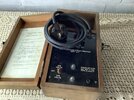I am told you used one of these

to test them. When I started as an electrician I did not see any, not a clue why, but think the water main to most homes resulted in a rather good earth? It was only when we went to plastic water mains, and relied on the earth rod, that the ELCB-v came in, first time I found one was around 1989 at a caravan site used for workers building Sizewell 'B', think the site left over from building 'A' station, and my fitting of earth wires rendered the units inoperative, and they were all changed to RCCB's as then called, was ELCB-c and became the RCD.
It was the problem with stay earths which resulted in the ELCB-v being phased out, I was told they were banned, but not sure on that.
Sorry I mentioned the ELCB-v now,
@zaarin_2003 must be totally confused.
@davidarthor146 post has resulted in the thread running off on a tangent.
I remember it was also Sizewell when I first came across the heavy use of RCD's, many values from 1 amp to 30 mA, with delays which should have ensured correct one tripped, but the problem was switches tend to only switch the line, and neutral was left connected, so finding earth to neutral faults was hard.
At last today with the RCBO at least the fault is on one circuit only, but seems we have lost
@zaarin_2003 he has never got back, any surprise with a thread like this?
I am afraid I am also guilty of fitting RCD's without testing the installation properly, yes used the insulation tester, but that uses DC, so gave no indication of the amount of leakage due to inductive and capacitive linking, I knew the limit was 9 mA, but had no way to measure the 9 mA, so removed a 100 mA RCD and fitted a 30 mA instead without testing first to see if a single RCD was appropriate. Just trusted to the lord.
This house never tested before CU change, just used all RCBO to be on safe side, then found the type B were in fact type AC in spite of saying type B on the packet. Since I have measured the total leakage at around 26 mA, so two RCD's would not have been appropriate, but how many do test? OK tester was cheap enough, around £35 for my new clamp on that can measure 1 mA increments in AC or DC, although the DC is a bit hit and miss, zeroing the meter is OK in theroy, but move the meter slightly and zero is out again. But I am not really worried about the RCBO's working they are just secondary protection as far as the RCD bit goes. And even a type A is only good for 6 mA, so unless it has some auto disconnect if over 6 mA flows, then rather pointless.



